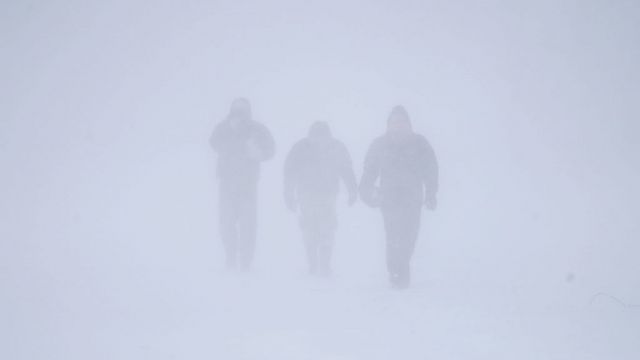A frigid winter storm has killed at least 18 people as it swept across the US, knocking out power to hundreds of thousands of homes and businesses and leaving millions of people on edge about the possibility of blackouts.
The storm unleashed its full fury on Buffalo, New York, with hurricane-force winds causing whiteout conditions. Emergency response efforts were paralysed, and the city’s international airport was shut down.
Across the US, officials have attributed deaths to exposure, car crashes, a falling tree limb and other effects of the storm.
At least three people died in the Buffalo area, including two who suffered medical emergencies in their homes and could not be saved because emergency crews were unable to reach them amid historic blizzard conditions.

Deep snow, single-digit temperatures and day-old power outages sent Buffalo residents scrambling on Saturday to get out of their houses to anywhere that had heat.
New York Governor Kathy Hochul said the Buffalo Niagara International Airport would be closed through Monday morning and almost every fire truck in the city was stranded in the snow.
“No matter how many emergency vehicles we have, they cannot get through the conditions as we speak,” Ms Hochul said.
Blinding blizzards, freezing rain and frigid cold also knocked out power in places from Maine to Seattle, while a major electricity grid operator warned the 65 million people it serves across the eastern US that rolling blackouts might be required.
Pennsylvania-based PJM Interconnection said power plants are having difficulty operating in the frigid weather and has asked residents in 13 states to conserve electricity through to at least Christmas morning.
The Tennessee Valley Authority, which provides electricity to 10 million people in the state and parts of six surrounding ones, directed local power companies to implement planned interruptions but ended the measure by Saturday afternoon.
The start of the NFL’s Tennessee Titans’ game in Nashville was delayed an hour by a planned power outage.
Across the six New England states, more than 273,000 customers remained without power on Saturday, with Maine the hardest hit and some utilities saying it could be days before electricity is restored.
In North Carolina, 169,000 customers were without power as of the afternoon, down from a peak of more than 485,000, but utility officials said rolling blackouts would continue for “the next few days”.
In the Buffalo suburb of Cheektowaga, two people died in their homes on Friday when emergency crews could not reach them in time to treat their medical conditions, according to Erie County executive Mark Poloncarz.
He said another person died in Buffalo and said the blizzard may be “the worst storm in our community’s history”.
It was taking ambulances over three hours to do one trip to a hospital, Mr Poloncarz said.

Forecasters said 28 inches (71 centimetres) of snow accumulated as of Saturday in Buffalo. Last month, areas just south of the city saw a record six feet of snow (about 1.8 metres) from a single storm.
Plows were on the roads, but large snow drifts, abandoned cars and downed power lines were slowing progress.
On the Ohio Turnpike, four died in a pileup involving some 50 vehicles. A Kansas City, Missouri, driver was killed on Thursday after skidding into a creek, and three others died on Wednesday in separate crashes on icy northern Kansas roads.
A utility worker in Ohio was also killed on Friday while trying to restore power, according to the Buckeye Rural Electric Cooperative. It said the 22-year-old died in “an electrical contact incident” near Pedro in Lawrence County.
A woman in Vermont died in a hospital on Friday after a tree broke in the high winds and fell on her. Police in Colorado Springs said they found the body of a person who appeared to be homeless as sub-zero temperatures and snow descended on the region.
Near Janesville, Wisconsin, a 57-year-old woman died Friday after falling through the ice on a river, the Rock County Sheriff’s Office announced.
The storm was nearly unprecedented in its scope, stretching from the Great Lakes near Canada to the Rio Grande along the border with Mexico.
About 60% of the US population faced some sort of winter weather advisory or warning, and temperatures plummeted drastically below normal from east of the Rocky Mountains to the Appalachians, the National Weather Service said.
As millions of Americans were travelling ahead of Christmas, more than 2,360 flights within, into or out of the US were cancelled on Saturday, according to the tracking site FlightAware.
Forecasters said a bomb cyclone — when atmospheric pressure drops very quickly in a strong storm — had developed near the Great Lakes, stirring up blizzard conditions, including heavy winds and snow.







